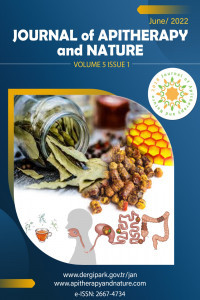An Exploration into the Relationship Between Propolis Production and Trypanosome Burden
An Exploration into the Relationship Between Propolis Production and Trypanosome Burden
___
- .
- Yayın Aralığı: Yılda 2 Sayı
- Başlangıç: 2018
- Yayıncı: Oktay YILDIZ
New Insights into Tropical Propolis: Propolis from Pitcairn Island
Boryana TRUSHEVA, Kristina GEORGIEVA, Milena POPOVA, Veselina UZUNOVA, Tihomira STOYANOVA, Violeta VALCHEVA, Rumiana TZONEVA, Vassya BANKOVA
Effects of Propolis on the Quorum Sensing of Selected Biofilm Producing Bacterial Species
K. TENNICK, S. WAFA, H. FEARNLEY, M. GOMEZ ESCALADA
Qualitative Analysis and Biological Evaluation of Propolis from Armenia and Georgia
Argyro PETROPOULOU, İoanna CHINOU, Konstantia GRAIKOU
The Biological Activities of Indonesian Propolis and It’ s Molecular Marker
Muhamad SAHLAN, Diah Kartika PRATAMI, Safira Candra ASIH, Andrea DEVINA, Alfiani Guntari MAHADEWI, Masafumi YOHDA, Siti FARIDA, Robiatul ADAWIYAH, Herbert SITUMORANG, Heri HERMANSYAH, Anondho WIJANARKO
Can Propolis Inhibit Infection Dynamics of Honey Bee (Apis mellifera L.) Viruses in vitro?
María İnmaculada GONZÁLEZ-MARTÍN, Eddy Valentín BETANCES-SALCEDO, İsabel REVILLA, Ana María VIVAR-QUINTANA
Caseinates Loaded with Red Propolis Extract
İsabel Cristina Celerino De Moraes PORTO, Clinston Paulino De ALMEIDA, Nataly Miranda Do NASCIMENTO, Amanda Barbosa WANDERLEY, João V. Lessa De OLIVEIRA, Felipe J. L. Barbosa Dos SANTOS, Valdemir Da Costa SILVA, İrinaldo Diniz BASÍLIO-JÚNIOR, Giselda Macena LIRA, Marta Maria Da CONCEIÇÃO, Ana Flávia
Toothpaste with Propolis “Apident” Shows Antimicrobial Activity in vitro
Klemen RIHAR, Dunja Gregorič EXEL, Adriana PEREYRA, Rok KOPINČ, Bratko FILIPIČ
Determination of Phenolic Acids in Raw Propolis Using Near Infrared Spectroscopy
Ana María VIVAR-QUINTANA, İsabel REVILLA, María İnmaculada GONZÁLEZ-MARTÍN, Eddy Valentín BETANCES-SALCEDO
GC-MS and UPLCA-PDA-TOF Profile of Polish and Eurasian Propolis
Jarosław WIDELSKI, Piotr OKIŃCZYC, Antoni SZUMNY, Jakub SZPERLIK, Anna KULMA, Zbigniew SROKA, Krystyna SKALICKA-WOŹNIAK, Tomasz MROCZEK
